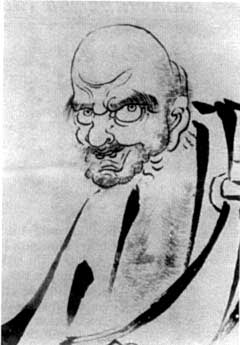Dōgen returned to Japan in 1227 or 1228, going back to stay at Kennin-ji, where he had trained previously. Among his first actions upon returning was to write down the Fukan Zazengi (普観坐禅儀; 'Universally Recommended Instructions for Zazen'), a short text emphasizing the importance of and giving instructions for zazen, or sitting meditation. Hakuin was greatly respected and had many disciples. At one time in his life, he lived in a village hermitage, close to a food shop run by a couple and their beautiful, young daughter. One day the parents discovered that their daughter was pregnant. Angry and distraught, they demanded to. Hakuin Ekaku (白隠 慧鶴, January 19, 1686 - January 18, 1768) was one of the most influential figures in Japanese Zen Buddhism. He is regarded as the reviver of the Rinzai school from a moribund period of stagnation, refocusing it on its traditionally rigorous training methods integrating meditation. Zen Master Hakuin's Letter in Answer to an Old Nun of the Hokke Nichiren Sect The 25th day of the Eleventh Month of Enkyo 4 (C.E. In this essay, translated from Japanese, D. Suzuki presents his evaluation of three pivotal figures in the history of Japanese Zen. The essay provides a valuable look at the approach to zazen taken by Dōgen, Hakuin, and Bankei, while comparing their views of awakening. The essay also reveals much about Suzuki’s views concerning Japanese spirituality (reisei).
Hakuin Ekaku (1685-1768) is widely acknowledged as the most important Zen Buddhist master of the past 500 years. He was also the most influential Zen artist of Edo-period (1615-1868) Japan, but unlike the highly studied monk painters of earlier centuries, he received no formal artistic training beyond the basic skills in handling brush, ink, and paper that were required for everyday writing.
Hakuin’s self-taught, spontaneous, yet masterly and inspired painting and calligraphy, just like his teachings and writings, expressed the mind and heart of Zen for monks and lay followers alike. With the aim of reaching out to people of all social and economic classes, rather than just the élite, he invented a new visual language for his religion, depicting everyday subjects and themes from other Buddhist sects, as well as Zen patriarchs and masters.
For this first exhibition in the West devoted to Hakuin, nearly 80 of his scrolls will be gathered from collections in the United States and Japan. Organized in collaboration with New Orleans Museum of Art, and curated by Audrey Yoshiko Seo and Professor Stephen Addiss. The Los Angeles presentation is made possible by LACMA’s East Asian Art Council.
Hakuin Ekaku (1685-1768) is widely acknowledged as the most important Zen Buddhist master of the past 500 years. He was also the most influential Zen artist of Edo-period (1615-1868) Japan, but unlike the highly studied monk painters of earlier centuries, he received no formal artistic training beyond the basic skills in handling brush, ink, and paper that were required for everyday writing.
Hakuin’s self-taught, spontaneous, yet masterly and inspired painting and calligraphy, just like his teachings and writings, expressed the mind and heart of Zen for monks and lay followers alike. With the aim of reaching out to people of all social and economic classes, rather than just the élite, he invented a new visual language for his religion, depicting everyday subjects and themes from other Buddhist sects, as well as Zen patriarchs and masters.
For this first exhibition in the West devoted to Hakuin, nearly 80 of his scrolls will be gathered from collections in the United States and Japan. Organized in collaboration with New Orleans Museum of Art, and curated by Audrey Yoshiko Seo and Professor Stephen Addiss. The Los Angeles presentation is made possible by LACMA’s East Asian Art Council.
The Sound of One Hand: Paintings and Calligraphy by Zen Master Hakuin is organized by the New Orleans Museum of Art
The Los Angeles presentation is made possible by LACMA's East Asian Art Council.

Hakuin Ekaku Paintings
Incomplete - Highlighted Objects, Links
Image: Hakuin Ekaku, Japan, 1685 1769, Daruma, 18th century, Hanging scroll; ink on paper, Image: 44 1/2 x 19 3/4 in. (113.03 x 50.17 cm); Mount: 77 3/4 x 25 in. (197.49 x 63.5 cm), Gift of Murray Smith. M.91.220.
- May 22–Aug 14, 2011
- Pavilion for Japanese Art
This exhibition is shown in two parts.
Part 1: May 22–June 28, 2011
Part 2: July 1, 2011–August 14, 2011

The Sound of One Hand: Paintings and Calligraphy by Zen Master Hakuin is organized by the New Orleans Museum of Art
The Los Angeles presentation is made possible by LACMA's East Asian Art Council.
Incomplete - Highlighted Objects, Links
.jpg)
Image: Hakuin Ekaku, Japan, 1685 1769, Daruma, 18th century, Hanging scroll; ink on paper, Image: 44 1/2 x 19 3/4 in. (113.03 x 50.17 cm); Mount: 77 3/4 x 25 in. (197.49 x 63.5 cm), Gift of Murray Smith. M.91.220.
Hakuin Song Of Zazen
Media
Hakuin Monkey Painting
Curator Rob Singer talks about the exhibition The Sound of One Hand: Paintings and Calligraphy by Zen Master Hakuin, on view through August 14, 2011.
| home | back to Zen Teachings: translations |
Hakuin's Song of Zazen |
|
Hakuin Is That So
| home |
